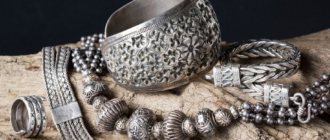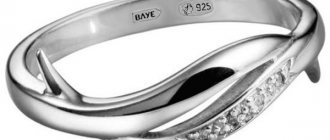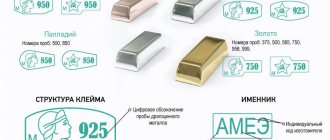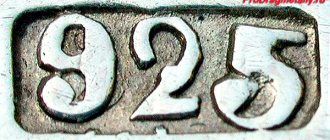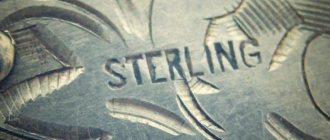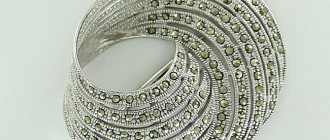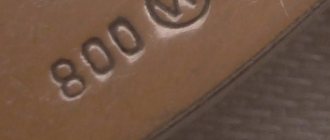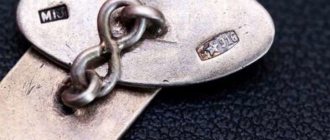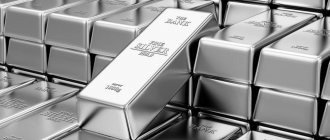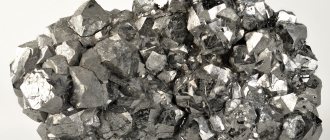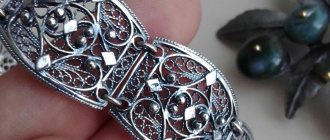Silver is the second most popular precious metal after gold. It has a sample that allows you to distinguish a fake from the original jewelry. Products made of high-quality metal look stylish and do not oxidize after long wear. In this article we will tell you what types of silver there are and how to identify the original accessory.
What is a sample and why is it needed?
Silver is a soft material that cannot be used to make jewelry. For this, alloys are used, and copper is added to silver. The finished alloy is strong, malleable and resistant to corrosion. In addition to copper, the following alloys are often added to the alloy: zinc, aluminum, cadmium, antimony, palladium, lead, iron, nickel, bismuth. Depending on the composition of the product, its characteristics, shade and cost change.
Fineness is a three-digit number that indicates the percentage of pure metal that is in the alloy. For example, 925 sterling silver accessories are 92.5% pure silver. The sample is necessary so that a person can determine whether the jewelry in front of him is real or a fake. If there is no stamp, it is most likely a fake jewelry or the sample has worn off due to prolonged wear of the accessory.
You can find products that contain 84 samples. Theoretically, it cannot contain 84 grams of silver and 916 grams of impurities. The value is simply indicated in a different measurement system. Until 1927, samples were determined using spools. If we convert this value to the metric system, the number will correspond to 875. In addition to the spool test, in ancient times the ratio of silver in products was measured using the lot and carat systems. Special tables have been developed where the generally accepted sample is converted into various values.
The influence of third-party factors on the cost indicator
The described method of finding out the cost of silver does not always give true figures. It may not be useful when it comes to purchasing or selling silver in the domestic market. This is influenced by the following factors:
- possible risks awaiting the Central Bank;
- situation on the world market.
The current political and economic situation in the country is also taken into account. The price of 1 gram of silver may also vary depending on the region and the bank where the purchase will be made.
In 2021, the silver rate in Russia
next:
- purchase – 30,014 rubles;
- sale – 31,702 rubles;
- market – 33.9411 rub. (calculated based on the rate on the international Forex exchange);
- CBR – 30.8 rubles.
One ounce of silver is valued at $15.25 on Forex.
Variation in prices for 925 and 999 silver
Of all the samples, 925 is considered the most common, and 999 is the most expensive. It is not recommended to buy products with a sample below 875 due to low quality. Due to the increased demand for such silver, the cost per gram may vary depending on the place of purchase or sale:
- In a pawnshop (when pawning), items made of 925 silver are accepted at a reduced price - from 18 to 22 rubles. per gram. This is due to the redemption option provided. If the product is put up for sale, the price tag rises to 31 rubles.
- On the stock exchange, the cost of the valuable metal fluctuates between 31-33 rubles.
- The store sells silver items at an inflated price - it is almost 20 times higher than the registration price. So, in a jewelry store they offer 1 gram of silver for about 600 rubles.
Other factors may also affect the cost of a silver item offered for sale in a store:
- appearance;
- country of origin (Chinese goods are the cheapest);
- the price of the metals that make up the alloy.
The last point refers to inclusions other than copper. These can be: cadmium, palladium, platinum. Silver items and jewelry are often plated with rhodium, which prevents them from tarnishing. Then 925 silver will cost more.
Before you buy something silver, you need to understand the existing hallmarks and cost differences. Each product made of this precious metal must have a corresponding mark. After all, argentum, like gold, is often counterfeited.
Source
What samples are known and what do the numbers mean?
In the metric system, which is followed in the CIS countries, the highest standard on silver is 999, and the lowest is 800. Previously, there were other designations, for example, in Soviet times, the standard 916 was popular, which was stamped on a barrel-shaped mark. There are a number of poor countries where jewelry with a value of 600 is in demand, but they are not durable. Below we will tell you what types of silver there are and the most popular types of metal.
Dining room
Just 10-15 years ago, silverware was common in every family. Today such products are not popular. Most people now use stainless steel appliances because they are affordable and attractive in appearance.
Technical
Technical silver is used to create electronics and photographic equipment. An alloy is called technical if its fineness is less than 800. The precious metal is high-strength and has good electrical and thermal conductivity. Lunar metal is widely used to produce:
- mirrors;
- films;
- radio components;
- space technology;
- equipment for catering establishments;
- prostheses;
- medical instruments;
- aviation.
Gold plated
A silver product with a layer of gold plating can add sophistication and high value to the finished item. But in addition to this, the additional layer increases the durability of the product. Gilding is suitable for making dishes and cutlery. If you use silver spoons in an acidic and salty environment, they will undergo a chemical reaction and darken. Gilded dishes retain their original appearance for a long time.
Filigree
Filigree silver is jewelry with complex patterns made from thin wire. Filigree or filigree can be openwork or background. You can get acquainted with this type of metal in any museum; most often, a similar decorative technique was used in the manufacture of pendants, amulets, glass holders, and cutlery.
Matte
A matte surface can be achieved using a sandblasting machine. Such jewelry cannot be polished; it does not have stones or decorative inserts. The finished decorations look as simple as possible.
The main feature of this type of silver is that it does not darken in air. Even if a dark tint appears on the surface over time, it can be removed during the cleaning process by soaking it in a special solution or using a sandblaster.
Leaf
Silver leaf is used to completely cover the decoration. You can notice this technique in temples, palaces, and ancient buildings. This precious metal is of the highest standard. But unlike gold leaf, it does not completely cover the domes. Silver requires plating and is less resistant to natural influences. To preserve the original appearance of products, durable varnishes are used.
Colloidal
The material is suitable for medical and cosmetic purposes. In pharmacies, products containing this metal are sold as dietary supplements, since their effectiveness in treating various diseases has not been proven.
Oxidized
This type of metal can be obtained thanks to silver and sulfur. Oxidized silver is durable, but it is not as strong as blackened silver, and therefore is not suitable for every item. A dark pattern is created under the film, which is very easy to damage if you start cleaning the finished product. This is the main disadvantage of silver jewelry.
The oxidation method paints products not only black. The color can be close to gray or dark purple. The finished product looks aged. To make a thing look more noble, it needs to be polished. Oxidized silver is used to make small jewelry.
Rhodinated
Rhodium plated silver is made by coating a material with a thin layer of rhodium. This metal is rare, and therefore products with it are among the most expensive. Rhodium is a durable precious metal, and therefore finished products are resistant to damage. Other benefits include:
- wear resistance;
- impact against deformation;
- bright shine.
Rhodium is most often used to coat high-grade and expensive jewelry.
Sterling
Many years ago, English coins were made from 925 silver, which were used to pay the residents of England. It was at this time that active trade was carried out. The coins were called sterling, and therefore the metal received this name. After the coins became popular, the pound sterling came into circulation.
Now sterling silver is a common metal in jewelry production. This is a fairly hard material, and therefore it is suitable for the production of household items.
There is also another story of the origin of the name of this metal: silver was minted by residents of Germany with the surname Easterlings. Sterling silver is durable and high quality. And even now it has a high price in jewelry and household items.
Blackened
Even before the advent of our era, the method of blackening was invented in Ancient Rus', due to which silver products acquired elegant patterns. To obtain niello, copper, silver, sulfur and lead were mixed. The resulting mass was engraved, and then the finished product was heated until distinct patterns appeared. The result was things of different shades, which made them unique.
After the discovery of this method of decoration, the blackening method began to be used for amulets and amulets. But in the 17th century, dishes, engravings and cigarette cases made of blackened silver began to appear. Despite the fact that finished items can be processed, they remain durable and do not require maintenance.
In Russia
In Russian jewelry stores you can find jewelry of two samples: 875 and 925. The first sample is inexpensive accessories that are fragile and cannot be machined.
The second test is placed on high-quality jewelry and is flexible, so you can make jewelry of any shape. Finished jewelry accessories also differ in appearance: 925-grade items have a bright shine and a white tint.
For the manufacture of souvenirs and tableware, 800 and 803 alloys are used.
In the world
All over the world, samples are not the same as in Russia. Let us describe what silver standards are in other countries:
- in Europe: 800, 916, 935;
- in Egypt - 600;
- in China it is almost pure silver.
What is sterling silver
In ancient times, English coins - sterling - were made from 925 silver. According to another legend, sterling silver was originally minted in Saxony in the Esterling region. This is how it got its name. Silver was used to produce coins that served for trade relations with England. And only after that the pound sterling came into use in Britain. Antique sterling silver was considered incredibly high quality, and is still highly valued for making household items, art, and jewelry.
The highest standard of silver in jewelry
You might think that 999 is the highest standard of silver. But only ingots are made from pure metal and stored in jars. In some countries, amulets are made from pure metal and serve as amulets. Jewelry is made from mixed metals to ensure it remains durable. If you try to make a bracelet, earrings or chain from pure silver, the metal will crumble and break.
To make special items, jewelers use 960 standard. It refers to a high-strength alloy, the use of which makes it possible to make fine details on jewelry. The finished products have a pleasant silvery tint and their properties do not differ from noble metal. But such products require special care and caution, as they are fragile.
Another high-quality sample is 925; it is very common among jewelry due to its plasticity. The products are optimal in terms of price-quality ratio. Coins are stamped from this alloy.
Metal that has won recognition all over the world
The beauty of noble silver has been known since time immemorial. Exactly when it was discovered remains a mystery to us. But, judging by written sources, silver jewelry was made by the ancient Egyptians. At that time, such jewelry was much rarer than gold, and therefore was very valuable.
If we look at the etymology of the word “silver”, we will notice that it comes from the Sanskrit word “argenta”, which means “light”. Indeed, the metal is naturally silvery-white in color.
Silver is quite rare in the depths of the earth. It is for this reason that it can safely be classified as a precious material.
By its nature it is a very soft metal with characteristic ductility. This property allows the material to be processed with particular ease.
Stretch, stretch, roll into thin plates - anything can be done with such metal. However, jewelers in most cases do not prefer to use pure silver to create jewelry. Why? The fact is that high-grade silver jewelry is easily deformed.
Pure silver is an excellent raw material for creating items such as collectible silver coins and bank silver bars. But in creating jewelry, craftsmen most often use alloys of silver with other non-ferrous and precious metals.
Silver is often found in combination with copper. Such material will fill silver with new and amazing properties. Jewelry items made from silver-copper alloy are very durable and hold their shape well. And they are not afraid of oxidation and corrosion.
This metal looks great in combination with other materials. These are gold, pearls, ivory, corals, and colored precious stones.
As for low-grade alloys, they make good table products, such as knives, forks, spoons, etc. Designers also often use such silver to make various home decor. These can be candlesticks, decorative vases, figurines and other table decorations.
Lowest standard of silver
The lowest standard is 600. The metal contains only 60% silver, it has a red tint due to the large percentage of copper. Sometimes they try to sell such jewelry to tourists at a high price, thereby deceiving buyers on vacation. But their cost is low, due to the low sample.
Jewelers make silver jewelry and 720 sterling silver - such products are the cheapest. The decorations have a yellowish tint. But such accessories will not last long; they quickly oxidize. Low-grade metal is excellent for the production of cufflinks, locks and fasteners. If you have a small budget, then it is better to purchase jewelry made from an alloy with a purity of more than 900, since cheap products quickly lose their appearance.
Medium-grade alloys include samples: 750, 800, 875. Tableware, dishes, and decorative elements are made from metal. Metal needs to be cleaned regularly to maintain its beauty. The most popular is 800 alloy; spoons, forks, pepper shakers, salt shakers, shot glasses, and glasses are made from it.
Technical metal and imitation
Technical silver is distinguished by its lack of fineness and precious metal content of less than 80%. This metal has its advantages - it is durable and lightweight, has good electrical conductivity and conducts light well. Therefore, technical silver has found its application in electronics and apparatus parts , as well as in industrial production.
have long been known , which formed the basis for the manufacture of silver ionizers for water and the popularity of silver tableware and jewelry. Due to the high cost of the metal, there is always a risk of it being counterfeited by fraudsters. Imitation of silver also occurs in the decoration of monuments and the manufacture of decorative items. Precious metal substitutes are also used in production equipment. Usually, instead of silver, they use:
- Nickel silver - this metal for the production of cutlery is necessarily coated with a small layer of pure silver. But when this layer wears off, a metallic taste will be felt when using nickel silver cookware.
- Cupronickel , an alloy that has received this name, combines 84 sterling silver, copper, manganese and nickel. Dishes are made from it, but they cannot be called useful .
The minimum value of jewelry standard accepted in Russia is 800. Everything else must be designated as costume jewelry.
How to determine the authenticity of silver
The easiest way to verify authenticity is to find a hallmark. You can also take the jewelry to a workshop or pawnshop, where experts will tell you what standard the product belongs to and conduct an assessment. Before purchasing, be sure to inspect the links and the appearance of the product so that there are no scratches or damage.
You can also conduct an experiment at home to identify the real metal in the product. To do this, place the decoration in boiling water. If the accessory is made of real silver, it will maintain the temperature of boiling water for several minutes and become as hot as water.
Another way to check the authenticity of a home is to try to attract the product with a magnet. Silver of the highest standard is not attractive. Also, after contact with a silver product, look at your hands, if they are stained, this means that there is too much zinc in the product.
You can also check the authenticity of the product using iodine. Drop a small amount of the product and watch the reaction of the metal. If it is real, then a dark spot will remain on the surface. If the item is made of real silver, there will be a speck on it when you rub the chalky piece.
But many jewelers have learned to fake samples and pass off products with low silver content as high-grade. You can determine the authenticity of a product by looking at the stamp. If the product or decoration is made of soft metal, then the sample will be soft.
To find out the authenticity of an antique product, you need to turn to professionals. Indeed, in past centuries, one sample was produced in specific years and placed in one place of branding. It is also worth considering that hallmarks differed in different countries. In Russia, on silver goods one could see the outline of a woman’s face in a kokoshnik, the hallmark number and the sign of the State Inspectorate. Fraudsters do not know about these nuances, and therefore, before you buy an antique item, you need to make sure of its authenticity.
Often, manufacturers of fakes transfer the mark from silver jewelry to costume jewelry. Only masters can check whether the mark is real. Only upon closer examination can traces of soldering be noticed. For this you will need a magnifying glass.
How to choose?
When buying a precious metal, you first need to determine the purpose of this action.
Following several rules will help you make the right choice:
- It is better to purchase silver only in official jewelry stores.
- Without leaving the store, you need to check the presence of the hallmark and hallmark.
- Due to the proven harmful effects of zinc, it is better to give preference to models without it.
- The optimal product sample is 925.
- Don't forget to take the receipt.
Silver markings on jewelry
The sample is indicated not only on paper tags that are sold along with jewelry. Marking is also required on the accessories themselves, so that you can see what percentage of metal they contain. The sample number is placed in different places:
- on a clasp or earrings;
- in the inner part;
- closer to the clasp.
If the product is very thin, then the sample is stamped on a small molten plate. On cookware, markings are placed on the back of the handle.
If there is no marking, this is a fake that contains no metal. Most often, unmarked products are made of medical or stainless steel. If your accessory is made in Russia, in addition to the sample number, there will be a small stamp on the jewelry.
How to protect yourself from counterfeiting
It happens that the 925 mark is on a low-quality product. There are funny cases: a person buys 825-grade jewelry, and when he goes online at home, he discovers that 825-grade does not exist at all. Fraudsters take advantage of buyers' ignorance.
How to determine the authenticity of silver at home
- Boil the product. If it is silver, it will quickly heat up so that it will be difficult to hold in your hand.
- Run over it with a lapis pencil: the silver will not darken.
- Scratch the item from the inside with a needle: the silver will not change color, but the silver plating will be erased, revealing a dark area.
- Rub the jewelry with chalk and rub vigorously between your palms. If the chalk powder has darkened, the silver is real.
The cost of silver depending on the sample
The cost of different silver samples is subject to change annually. You need to choose which silver to buy based on your budget. If finances allow, you need to choose high-quality jewelry.
The main factors that influence the price of silver products:
- metal price rate on the international exchange;
- try;
- product weight;
- trade fair;
- the presence of decorative elements and stones;
- markup in a retail store.
To understand whether the price offered for silver jewelry is adequate, you need to compare its value at a pawnshop. The price of finished jewelry depends on the standard of the silver and how many impurities it contains. The higher the standard, the higher the price of accessories. If we talk about antique things, the amount of pure metal is not always taken into account; the cost of the product is determined by its condition, weight and year of manufacture.
Silver is a noble metal, jewelry made of which looks attractive on the body of women, men and children. But in order for the product to serve you for a long time, you need to choose high-quality, high-quality accessories. The article described which silver samples are suitable for jewelry, dishes or decorative elements.
Rules for choosing silver products
Please note that when buying dishes or jewelry at local markets in foreign countries, you can get cupronickel or technical silver instead of the promised silver. It is almost impossible to distinguish them externally, but even short-term use will reveal all the shortcomings of counterfeit silver.
It is safest to buy jewelry and tableware in trusted jewelry stores or directly from the manufacturer through an online store .
Not sure which sample to choose? Choose based on the purpose of the product. For example, household silver with 87.5% pure metal in its composition is suitable for tableware, and for jewelry it is better to pay attention to silver with 925 purity.
Recommendations for care, cleaning and storage
The technology for caring for and cleaning silver is the same as for gold: we wear it carefully, take it off before running a hundred meters, do not store it mixed with other jewelry, rinse it with soapy water, polish it with a cloth, do not use abrasives.
Special attention is required to blackened silver and to products with stones. An acidic environment, ammonia and soda are contraindicated for them. If the jewelry is set not with stones, but with amber, corals or pearls, then it is better to refuse to clean it yourself and take the item to a workshop.
